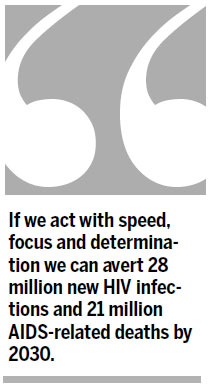China leads fight against AIDS
By Catherine Sozi (China Daily) Updated: 2014-11-29 09:08
Over the years, HIV programming has responded to the epidemic by investing significant financial and human resources in all regions of China, resulting in better health for everyone. Efforts to address HIV transmission through blood and blood products have been successful.
Last year, 110 million people tested for HIV. In addition, millions of condoms were distributed among key groups, including female sex workers and their clients, and men who have sex with men. China's antiretroviral therapy program for people living with HIV/AIDS has been significantly scaled up with more than a quarter of a million people currently on treatment. And the country has pioneered the innovative "Test and Treat" program for key groups which makes treatment available to people who test HIV positive as soon as possible, regardless of their immune status. The widespread availability of antiretroviral treatment for HIV positive people has led to a decrease in mortality and a reduction in mother-to-child transmission rates.
But, to quote Nelson Mandela, "After climbing a great hill, we find that there are many more hills to climb."
In spite of the hard work that has gone into the programming, data tell us that China still has lots more to do.
As in a lot of other countries, HIV services in China still do not consistently reach some people. Key groups including gay men and other men who have sex with men, transgender people, and people who buy and sell sex are at higher risk of contracting HIV and need to access effective prevention and treatment services.
While China has used its public health infrastructure effectively in delivering services to some of its most populous cities and some of the furthest regions, there is a need to tailor the services to meet the needs of key groups and expand community-based testing and treatment approaches. Health workers and public officials need to create an environment that encourages people who are hard to reach and their families to voluntarily access key services.
Strong commitment from China's top leadership has led to a big expansion in the domestic funding for AIDS response and the country has moved into a position of complete self-sufficiency. However, it is clear that health financing is no longer just about money. China needs to increasingly go beyond its initial success in the roll-out of large-scale HIV programs and focus on "how" to reach people who are currently falling through the cracks and all too often not accessing life-saving prevention, treatment and care services.
China's reflections on how to reduce costs and innovations in its health system will benefit many people, and the country can demonstrate how strategic approaches to spending can move the world toward ending the AIDS epidemic.
UNAIDS vision for ending AIDS as a public health threat by 2030 can be a reality in China and the lessons learnt from China can re-engineer HIV efforts across the world.
The author is UNAIDS country director, China.











